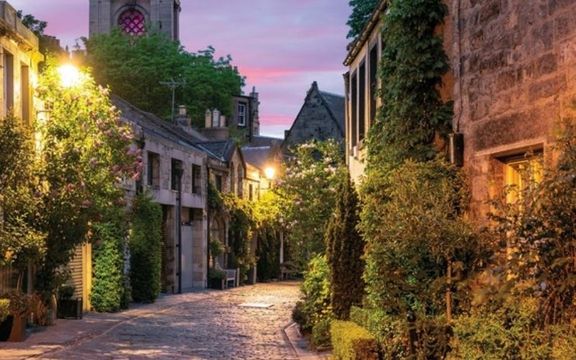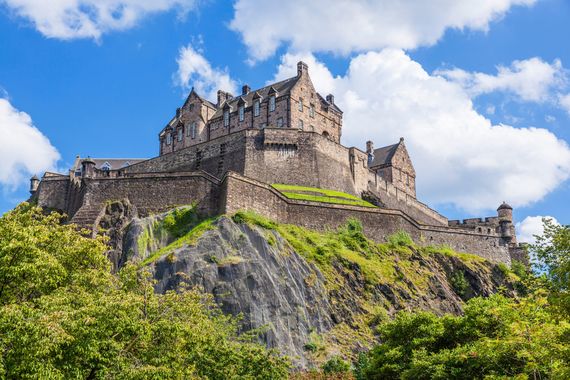
EdinburghGetty
Welcome to Edinburgh, Auld Reekie, the Athens of the North, the seat of Scottish culture and center of its history for the past 600 years.
A city truly unlike anywhere else. Out of all the cities in Great Britain, Edinburgh stands apart. Scotland’s capital city does not really look or feel like the contemporary world capital it is.
Like Rome, the city was built on seven hills. With that caveat, Edinburgh is a very
walkable city. Its charm for visitors lies in a relatively compact area for the city’s size.
And visitors it gets aplenty, entertaining some 4 million guests a year.
It takes more time to see Edinburgh than visitors generally can afford to give the city.
With most folks just having a day (or two or three) to spend, seeing the essential, feeling
its soul and making the most of Edinburgh means one thing: Location, location, location.
In the absolute heart of the city, the room with the best view in Edinburgh has to be
Room 114 at the Old Waverley Hotel. Facing Princes Street, the Old Waverley sits at the
corner of St. David Street diagonally across from Waverley Station, the beating heart of
the city’s railway.
There is no elevator from the hotel’s ground floor entrance, sandwiched between two
shops and the reception areas above. Room 114 occupies the third-floor corner,
overlooking the central boulevard and principal shopping street of the city, but just above
its noise. From the cozy bow window alcove, it looks out over the valley of the Princes
Street Gardens to Castle Rock and the impregnable walls of Edinburgh Castle.

Edinburgh Castle
Exploring the New Town neighborhood
Across the street from the front window of Room 114 stands the Scott Monument, raised
in 1844 and at 200-feet high, it’s the second-largest monument to a literary figure in the
world.
It honors Sir Walter Scott, not only Scotland’s preeminent historical novelist but a hero
of its culture. Scott’s imprint lies throughout the city: Waverley Station (after his Waverley
novels), as well as the hotel name and the Abbotsford pub just around the corner (after
his baronial Border’s home), are just the beginning.
The influential writer, however, is far from the only figure memorialized by monument; Edinburgh is a city of statues and columns remembering Scottish and British military and cultural heroes: Dr. Livingstone, David Hume and Adam Smith, the Duke of Wellington and Lord Nelson.
Princes Street itself runs only five long blocks, its pavements always bustling with local
shoppers and tourists. Edinburgh’s central tram line runs down the middle and every city
and regional bus line must converge on this street (count a dozen or 15 in view at any time during the busiest hours).
The Princes Street Gardens evolved when the “Nor’ Loch” below the Old Town was
drained in the 18th century for the building of the planned Georgian New Town. The
extensive civic gardens run from the Scott Monument the length of the street with broad
lawns, immaculate flower beds concert stage and a scattering of vendors providing
refreshments. The middle, what is known as The Mound, holds the elegant classical
buildings of the Scottish National Gallery and the Scottish Academy of Art and
Architecture.
Read more
St. David Street leads a full block uphill from the Scott Monument to St. Andrew Square,
a lovely civic park gathered around a 41-foot classical column honoring the First
Viscount Melville. Along the low ridge running parallel to Princes Street, the stately
boulevard of George Street leads to Charlotte Square with Edinburgh’s monument to
Prince Albert. Its upscale shops and restaurants front financial and insurance firms that
help the city prosper.
From Room 114’s bowed window, across St. David Street, Jenners has been
Edinburgh’s major department store for generations. While Jenners shows its posh face
to Princes Street, its back doors open onto Rose Street. A cobbled, pedestrian alley
running the long blocks of Princess Street, Rose Street is a concentration of eateries and
pubs of all descriptions, from classically Victorian to contemporary chic and cheery.
When there’s a party to be had in Edinburgh, Rose Street is party central.
Beyond Scott’s memorial, the gardens and the rail lines, the silhouette of the Old Town
leans downhill from the castle. It shrugs its irregular, dark back to the valley and faces
the Royal Mile, many of its ancient buildings still blackened with the coal smoke that
gave the city its Auld Reekie nickname.
Doing the Royal Mile
There’s no easy stroll to get by foot from Princes Street to the Old Town and that castle
fortress seen from the window. It’s a climb, however, that can be minimized by cutting
through Waverley Station with its escalators and lifts. Then, it’s steep pavement or long
Cockburn Steps up to the cobbled Royal Mile.
Somehow, it is always from the top of Castle Rock that visitors start their descent of the
Royal Mile, which changes its street name several times along the way. The broad
esplanade of Edinburgh Castle affords spectacular views over Princes Street Gardens
and the New Town below. Past Calton Hill and its monuments, Leith, Edinburgh’s
historic harbor spreads into the Firth of Forth.
The decommissioned Royal Yacht Britannia sits moored in drydock, justly one of the city’s most popular attractions.

Edinburgh
The Castle
The foundations of Edinburgh Castle began in the early 1100s. There have been many
alterations over the centuries but the walls that encompass St. Margaret’s Chapel, built
by King David I, in 1130, make it the oldest building in Edinburgh. The castle complex also contains the Scottish National War Memorial and the Scottish crown jewels and
regalia, known as the Honours of Scotland.
From the castle esplanade, it’s all downhill. Both sides of the cobbled, largely pedestrian
old high street is lined with buildings of many styles and centuries dating back 500
years.
Crowds are omnipresent except in the darkest few months. There are enough
attractions, museums, pubs and tourist shops to take several days to exhaust. The
Camera Obscura, the World of Whisky and the Witchery and that’s just in the first block.
There must be a hundred shops selling Scottish woolens and kit: cashmere scarves,
lamb’s wool sweaters, full tartan kilt outfits and Walkers shortbread. And almost as many
purveyors of hundreds of malt whiskies, both shops and pubs. Buskers in full kilt
ensemble play the bagpipes and other instruments and sometimes sing Scottish songs
to the sky.
You might visit Gladstone’s Land, one of the oldest buildings on the Royal Mile, now in
the care of the National Trust for Scotland. Dating from the 1600s, the narrow townhouse
is furnished as an affluent city merchant would have lived in the 17th century, with
original Renaissance painted ceilings. Tuck your head down any of the narrow alleys
called closes, where most of the inhabitants for centuries lived in dim, crowded
tenements hidden around courtyards from the light of the Royal Mile.
Back at Room 114, it might be time for a cup of tea and shortbread in the alcove and to
watch the world go by on Princes Street. Edinburgh’s iridescent story goes on: The
Botanic Gardens, the Forth Bridges, Edinburgh University, the Scottish National Portrait
Gallery, Grassmarket, performance venues and cuisines from around the world. But they
might have to wait for another day.





Comments